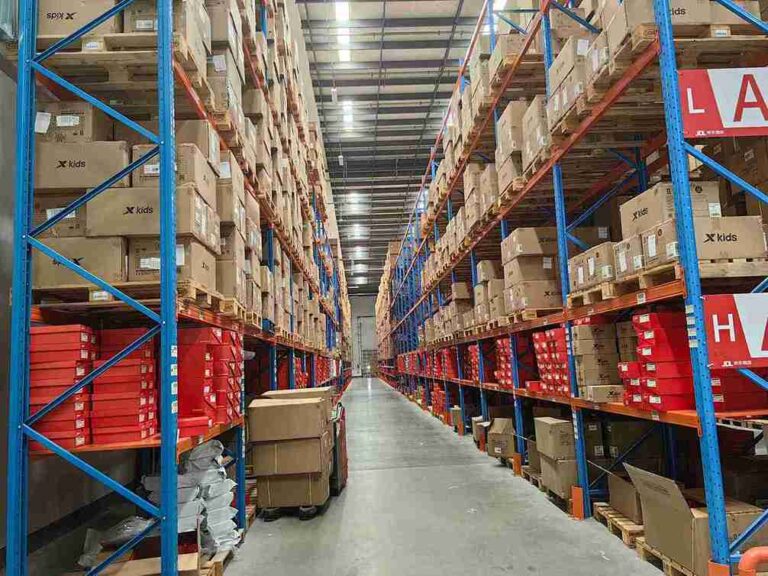📐 "First 50 Enterprise Queries Get Custom 3D Warehouse Design" Plan

Introduction: The Critical Need for Warehouse Racking Collapse Prevention
Every year, warehouse racking collapses cause catastrophic accidents—crushing injuries, fatalities, and millions in damaged inventory. The Occupational Safety and Health Administration (OSHA) reports that improper racking maintenance and overloading are leading contributors to these disasters.
For warehouse managers, warehouse racking collapse prevention isn’t just about compliance—it’s about protecting lives and ensuring business continuity. This guide delivers proven strategies to prevent racking collapses, covering structural integrity, OSHA compliance, employee training, and emergency response.
Whether operating selective pallet racks, drive-in systems, or cantilever racks, this comprehensive safety playbook will help businesses minimize risks and maximize operational efficiency.

1. Why Warehouse Racking Collapses Happen (And How to Stop Them)
1.1 Overloading: The Silent Killer of Rack Systems
The most common cause of warehouse racking collapse prevention failures is exceeding weight limits. Every rack has a maximum load capacity, and ignoring this leads to beam deflection, upright buckling, and catastrophic failure.
Prevention Strategy:
- Label load limits clearly on every rack section.
- Train staff on proper weight distribution.
- Use weigh scales to verify pallet loads before storage.
1.2 Forklift Collisions: A Leading Cause of Rack Damage
Forklifts striking racks is a daily hazard in warehouses. Even minor impacts can weaken structural integrity, leading to progressive failure.
Prevention Strategy:
- Install steel column guards at impact-prone areas.
- Enforce speed limits (under 5 mph in aisles).
- Use RFID collision avoidance systems for high-traffic zones.
1.3 Poor Installation & Neglected Maintenance
Improperly assembled racks or missing bolts create weak points. Without routine inspections, minor issues escalate into full collapses.
Prevention Strategy:
- Hire certified installers for initial setup.
- Conduct monthly rack inspections (document findings).
- Replace damaged components immediately—no exceptions.
1.4 Environmental & Seismic Risks
Earthquakes, hurricanes, and heavy vibrations can destabilize racks. Warehouses in seismic zones require reinforced racking systems.
Prevention Strategy:
- Use seismic-rated uprights (ANSI MH16.1 compliant).
- Install cross-aisle bracing for lateral stability.
- Anchor racks to concrete floors with epoxy bolts.
2. Warehouse Racking Collapse Prevention: 7 Expert-Backed Tactics
2.1 Implement a Rigorous Inspection Program
OSHA mandates that warehouses inspect racks annually, but best practices demand quarterly professional audits + weekly visual checks.
Inspection Checklist:
✅ Beam connections (no cracks, missing clips)
✅ Upright alignment (no leaning or splaying)
✅ Floor anchors (tight, no corrosion)
✅ Load capacity labels (visible, accurate)
2.2 Enforce Strict Load Management Policies
Overloaded racks = collapse risks.
Best Practices:
- Never exceed Dynamic Load Capacity (DLC).
- Distribute weight evenly—no single-sided loading.
- Use pallets within rack dimensions (no overhang).
2.3 Upgrade to Impact-Resistant Racking
Standard racks won’t survive repeated forklift hits. Invest in:
- 3-inch steel column protectors
- Rubber-faced guardrails
- Modular racking with replaceable parts
2.4 Train Employees on Rack Safety Protocols
Human error causes 60% of rack failures.
Training Must Cover:
- How to spot damaged racks (bends, rust, loose bolts).
- Proper pallet placement techniques.
- Emergency shutdown procedures if collapse is imminent.
2.5 Reinforce High-Risk Racking Zones
Narrow aisles, mezzanines, and bulk storage areas need extra protection:
- Double-deep racking? Add extra uprights.
- Automated storage? Install laser alignment sensors.
2.6 Use Technology for Real-Time Monitoring
Smart warehouses deploy:
- Strain gauges to detect overloading.
- AI-powered cameras to identify rack deformities.
- Vibration sensors for seismic activity alerts.
2.7 Develop a Collapse Emergency Response Plan
If a rack fails, every second counts.
Action Steps:
- Evacuate personnel immediately.
- Cordon off the collapse zone.
- Call a structural engineer for assessment.
- Document for OSHA compliance.
3. Choosing the Safest Racking System for Your Warehouse
3.1 Selective Pallet Racking (Best for Accessibility)
✅ Easy loading/unloading
⚠️ Requires strict weight discipline
3.2 Drive-In Racking (High-Density Storage)
✅ Maximizes space
⚠️ Needs reinforced uprights
3.3 Push-Back Racking (LIFO Storage)
✅ Reduces aisle space
⚠️ Higher maintenance demands
3.4 Cantilever Racking (Long Loads)
✅ Ideal for pipes, lumber
⚠️ Requires deep anchoring
3.5 Mobile Racking (Ultra-Dense Storage)
✅ Saves 50%+ space
⚠️ Complex maintenance
4. OSHA & ANSI Compliance: Non-Negotiable Safety Standards
Ignoring regulations invites fines, lawsuits, and shutdowns.
Key Standards:
- OSHA 1910.176(b) – Safe material storage
- ANSI MH16.1 – Rack design & maintenance
- FEM 10.2.02 – European seismic racking rules
Compliance Tips:
- Keep inspection logs for 5+ years.
- Display load capacity charts prominently.
- Require certifications for rack inspectors.
5. Case Study: How a 3PL Warehouse Avoided Collapse
Challenge: A Midwest logistics hub suffered three near-miss rack failures in 2022 due to forklift damage and overloading.
Solution:
- Installed 200+ column guards.
- Trained 150+ staff on load limits.
- Adopted AI rack monitoring.
Result: Zero incidents in 18 months, with 20% faster loading times.
Conclusion: Warehouse Racking Collapse Prevention Saves Lives & Profits
Preventing rack collapses isn’t optional—it’s a moral and legal obligation. By enforcing load discipline, investing in impact protection, and training teams, warehouses can eliminate 90% of collapse risks.
Need a rack safety audit? Contact certified racking engineers today for a complimentary risk assessment.
FAQs: Warehouse Racking Collapse Prevention
1. How often should racking be professionally inspected?
Minimum: Annual OSHA inspections. Best practice: Quarterly audits + weekly visual checks.
2. Can bent rack uprights be repaired?
No—replace them immediately. Bent uprights lose 70% of load capacity.
3. What’s the #1 mistake causing rack collapses?
Overloading beams beyond their rated capacity.
4. Do seismic zones require special racking?
Yes—seismic-rated uprights and cross-bracing are mandatory in earthquake-prone areas.
5. How do I calculate load capacity for my racks?
Consult the manufacturer’s engineering specs or hire a structural engineer.




